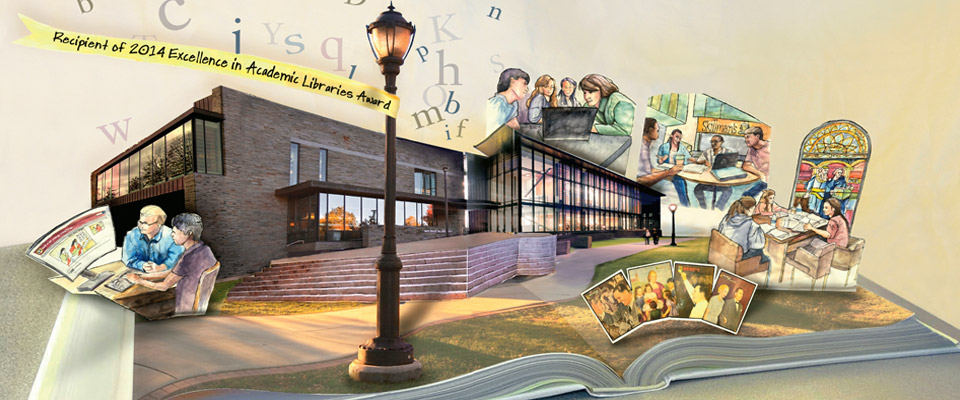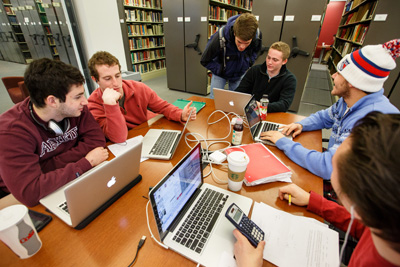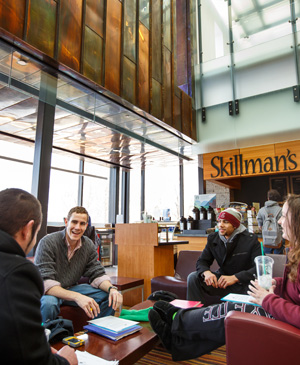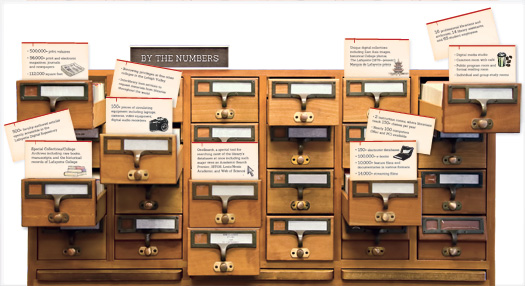Mar 21, 2014
Then & Now
1861-1899 South College Reading Room 1875-1897 Ward Library, second floor Pardee Hall The library of Christopher Ward of Towanda, Pa., a collection of…

by Kate Helm | Illustration by Heather Reinert
Chemistry major Andy Polanco ’15 found it difficult to focus on his studies during his first year. Then, he discovered Skillman Library.
“Skillman has helped me realize more of my potential,” he says. “If I need to work on a group project, want to study with a friend, or focus on completing an assignment, I go to the library. When I’m around people that are focused, I am able to concentrate more.”
Polanco often checks out one of the library’s laptops so he can study anywhere in the building. His favorite spot is the conference room in Skillman Café with its wall of glass windows where sunlight pours in and cheerful yellow walls that keep the room bright even after dark.

Having studious company was important for Sarah Kolba Hoover ’10, too, who found that research could be lonely. She frequently used Skillman’s group study spaces because being around other students held her accountable—and provided an outlet to take a break and chat. Summer research students, she says, often walked down the row of study rooms on the second floor to see who was around so they could catch up or exchange stories about their work.
Hoover created her own interdisciplinary major in medieval and Renaissance studies at Lafayette and earned a master’s in art history from University of Illinois, Urbana-Champaign, where she also expects to complete a master of library science this year. She was inspired to embark on a career in archives by the opportunity to study rare documents—including, she notes, the Nuremberg Chronicle. She and others in the course High and Popular Culture in Medieval and Renaissance France visited Skillman’s Special Collections and College Archives to peruse this example of one of the best-documented early printed books from the late medieval period and particularly the intricate woodcut illustrations.
As a member of the History Club, she visited College Archivist Diane Shaw to learn more about the College’s history and invited Shaw to speak at club meetings. She spent a semester working in Special Collections.
Given the academic demands facing students, it is no surprise that Skillman has become central to social life on campus. Tom Brinkerhoff ’13, who is pursuing a Ph.D. in history at University of Pennsylvania, rarely used the library alone. Even if his friends were working on different projects, they often reserved a study room or table to complete their work together. Spanish tutoring sessions and Writing Associate meetings were often held at Skillman Café.
Polanco likens the library to Farinon College Center—the main hub for dining and socializing—but with books.
“If the best thing a college library can be is used by its students and faculty, Skillman Library has been immensely successful.”
—NEIL MCELROY, DEAN OF LIBRARIES
Skillman opened in 1963. The selected location, in the center of campus, at the head of the Quad, signifies its central importance to the College’s academic mission. A major renovation in 2004 added 28,555 square feet and transformed the building into a learning and information center for the 21st century, including spaces for collaborative study, a spacious natural light-filled reading room, digital media center, and enhanced technology throughout (see “By the Numbers”).
Now at its 50th anniversary, Skillman has grown, adapted, and evolved to meet the rapidly changing needs of students and faculty. It is poised to become a national leader among liberal arts colleges in the area of digital scholarship.
As one of just three liberal arts colleges among the 70 members of the Digital Library Federation (DLF), a program of the national Council on Library and Information Resources, Lafayette is developing an institutional model for digital humanities in the liberal arts environment. Skillman is organizing a forum for representatives from about 20 liberal arts colleges and research universities to identify the requirements for sustainable management of digital scholarship in conjunction with the DLF annual meeting this fall.
For students who were among the first to walk through its doors to those today, the library has been central to their academic pursuits. Richard Koplin ’64 lived in a fraternity and found academic refuge in a cubicle on the second floor. Koplin, a renowned ophthalmologist and clinical associate professor at New York Eye and Ear Infirmary, recalls Skillman’s predecessor in Van Wickle Hall as a “lovely vestige of the past,” but uncomfortable and lacking a student-friendly atmosphere.
Like Koplin, John Hench ’65 sought out the library for studying without the distractions. Hench, who retired in 2006 as vice president for collections and programs, American Antiquarian Society, Worcester, Mass., remembers making good use of Skillman’s lockers while working on his honors thesis on personal liberty during the Civil War. Having one location to store his research materials rather than having to carry them back and forth was a big help.
Koplin says the experiences of the library he remembers pale in comparison to the vibrancy that students experience today.
That vibrancy has inspired Alena Principato ’15, an English major, to pursue a master’s degree in information science after graduation. A reference assistant who serves as a library ambassador, Principato has found mentors among the librarians, including Amy Abruzzi and Kylie Bailin. She helped Bailin with the library’s communications plan and this year’s library orientation presented to all students through their First-Year Seminars. Library Ambassadors is a student group that advises the library on improvements to library services, resources, and policies.
“The library is an important component of academic success, but it offers more than a place to study,” says Principato, whose favorable impression as a prospective student of the building’s design and facilities influenced her decision to attend Lafayette. “It is a hub for programs, events, and art exhibits. I’ve attended lectures by prominent speakers, participated in a flash mob celebrating Banned Books Week, and judged entries for the annual Edible Books Competition. You can even grab a coffee and snack at the library café.”
It’s true. Most of the old rules banning eating, drinking, and talking are gone. Two of the library’s signature spaces, Rothkopf Reading Room and Simon Room, are designated as quiet areas.
For Zainab Hussein ’17, the library is her favorite place on campus. She loves telling a story about the day her 11 a.m. class was cancelled. She had just finished breakfast. A friend asked what she was going to do with her newfound free time, and, of course, she was going to the library.
“That, to me, is a normal thing to do!” says Hussein, an electrical and computer engineering major from Nairobi, Kenya. “It is way more than just a place for academic books and rigorous study. While I do most of my studies there, I also hang out with my friends, borrow a Kindle for leisure reading, and check out DVDs from the collection. Having Skillman Café in the same building makes it a good environment for both academic and social use. I can’t imagine life without the library.”
Jeff McCafferty ’89 agrees, describing Skillman as the “symbolic and practical heart” of the College, a place that serves all students and faculty.
Now associate vice president of strategic planning for the American Public University System, Brick, N.J., McCafferty became familiar with the library’s resources while working with Ilan Peleg, Dana Professor of Government and Law, on a book about the Israeli-Palestinian conflict.
Each day during his senior year, McCafferty spent time studying references for his thesis on the media’s response to the Intifada. For his topic, the microfilm and microfiche collection was invaluable. At the time it enabled him to research newspapers from around the world that were not carried in print form.
Today, the library has invested in substantial electronic collections of historical periodicals including full text of The New York Times, Wall Street Journal, Los Angeles Times, Chicago Tribune, and London Times from their first issues in the late 18th to early 19th century, and international newspapers are available through LexisNexis and World News Connection.
Brinkerhoff, a Benjamin Franklin Fellow at Penn, also benefited from the library’s resources. A double major in history and Spanish, he wrote an honors thesis on propaganda produced for children by the Argentine government in the 1940s and 1950s. The source material was not available in any U.S. library nor was it accessible in official Argentine archives.
 “The library purchased over 30 children’s magazines printed by the Peronist government in the late 1940s and early 1950s, which were critical to my research,” he says. These became part of the College’s Special Collections. “I have yet to tell that story, either to faculty and students at Penn or other academics, and not have them respond, ‘Wow!’ It is just another example of the College’s continued support of undergraduate research, with Skillman Library at the center of that initiative.”
“The library purchased over 30 children’s magazines printed by the Peronist government in the late 1940s and early 1950s, which were critical to my research,” he says. These became part of the College’s Special Collections. “I have yet to tell that story, either to faculty and students at Penn or other academics, and not have them respond, ‘Wow!’ It is just another example of the College’s continued support of undergraduate research, with Skillman Library at the center of that initiative.”
Brinkerhoff recalls receiving an email at the end of his junior year detailing all of the library’s resources and the help reference librarians could provide. “I scheduled a meeting with Lijuan Xu, and we reviewed different databases and resources. She was very generous with her time and always went out of her way to help me with my research.”
Skillman’s affiliation with the Interlibrary Loan Service benefited both Brinkerhoff and Principato, who is working as an EXCEL Scholar with Christopher Phillips, assistant professor of English, to develop a database of 19th-century lending records of Easton Library to facilitate an analysis of reading patterns. Librarians were able to obtain a copy of an article she needed that was available only in two European libraries.
For her First-Year Seminar, Principato used documents from Special Collections, including letters written by the Marquis de Lafayette and George Washington to each other, to create historical narratives. She’s now serving as an intern with Shaw in Special Collections.
Elaine Stomber ’89 recalls the building as a dark place to study without great space for group interaction. As a student worker in Special Collections her junior and senior years, she processed the historical photograph collection, completed an academic internship to process the College’s 19th-century literary society records, and worked with the Marquis de Lafayette materials.
That experience facilitated her pursuit of a career in special collections in museums and libraries. “It is an unusual route for someone in my field because most archivists are not able to gain the necessary knowledge and experience without an MLS with an archives concentration,” she says. “I’m extremely grateful for the opportunities provided to me at Skillman, and I was happy to return to Lafayette in 2000 where I could work with our next generation of archivists.” Her daughter, Clare Stomber ’17, is now a student assistant at Skillman.
Students use the library for studying, meeting friends, and conducting research. For some it is a place for an interesting campus job or where they conduct research as an EXCEL Scholar. Whatever path leads them there, they all experience discoveries, make new intellectual connections, find mentors, and sometimes learn about career paths they had not considered before.
One tradition seems consistent—flocking to Skillman to catch up. Hench walked there after dinner with his fraternity brothers, noting that Skillman’s open architecture made it an ideal place to run into friends. Michael LeWitt ’70 was among a group of “library aficionados” who studied there regularly, sometimes using conference rooms for group study or projects. Some Sundays it seemed to McCafferty that the entire campus had gathered at Skillman to fill each other in on their weekend activities.
Clearly, students past and present think a lot of Skillman Library. They’ve used it well.

To read the facts and figures about Skillman Library that appear in this illustration, see the gallery above in this article.
1861-1899 South College Reading Room 1875-1897 Ward Library, second floor Pardee Hall The library of Christopher Ward of Towanda, Pa., a collection of…
For Josh O’Harra ’97, shifts as a student worker on Skillman’s circulation desk led to a tradition of exploring the stacks on Friday nights. He ran…
For the 50th anniversary, June Schlueter, Dana Professor Emerita of English and former provost, and her husband, Paul Schlueter, established an endowment…